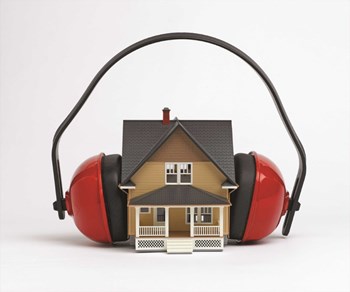
Noise is a key quality-of-life problem for almost anyone living in a densely-packed urban environment. It’s the bane of many a condo-dweller’s existence, and over the years engineers, architects, and designers have tried any number of ways to reduce the problem of noise in multifamily buildings—some more successfully than others. While noise is in the ear of the beholder, there are many products and techniques on the market to help mitigate the clinks and clanks of condo living.
When Noise Annoys
As long as people have ears and the ability to use them and live in close quarters with others, there will be problems with noise. It’s just human nature. While any unwanted sounds can be bothersome to residents, there are different types of noise.
Alicia Wagner, an acoustical consultant at Acetech in Cambridge, Massachusetts, says that there are three main types of noise: airborne noise, impact noise and outside noise. Airborne noise is transmitted through a wall, ceiling or floor structure and goes into an adjacent condominium—for example, the sound of the TV from upstairs or hearing two neighbors argue from below. Impact noise is anything that exits the structure and creates vibrations actually in the floor structure or the wall structure. Examples can include walking around or moving furniture. Lastly, outside noise is anything that comes from the outdoor environment, such as traffic and sirens. She adds that impact noise is particularly bothersome “especially in the New England area, where we have a lot of older buildings that are made with wood frames. Wood frame buildings tend to have more difficulty isolating one unit from another.”
Mandy Kachur, vice president of public relations for the Institute of Noise Control Engineering/USA, says, “Sounds that are transient, that come and go, that start and stop”—like my wife’s work on the plate—“or tonal noises, like whistles, tend to be more annoying than a steady broadband of white noise”—like the washer and dryer.
What distinguishes sound from noise, however, is the ear of the beholder. “Complaints arise from the noise that someone else is making,” says Kachur. “It doesn’t matter how much noise you make.”
This subjectivity can also pose a potential problem when experts come in to measure the frequency of the noise. Joseph Dragos, owner of New England Soundproofing in Boston says, “As far as measuring sound, yes, we can measure it and we can say, ‘Okay this is 40 decibels, it is acceptable,’ but it is the nuisance that is the problem. What happens is the typical sound is approximately 50 to 60 decibels and if you go down to 30 decibels it’s not going to hurt you but the problem is even though the decibels are low and it is acceptable, it is a nuisance. It’s not like a jackhammer is going off outside. It’s listening to the footsteps at 2 o'clock in the morning when the people upstairs come home after from the bar and the voice gets a little louder. Those are the complaints.”
Noise is Subjective
Unfortunately, because the concept of noise is so subjective, it is has been difficult to establish some type of regulations and building codes for it. There are general guidelines for builders and developers to adhere to in order to establish some type of sound barrier between units.
There are codes such as the Uniform Building Code that state that “for example that the noise reduction between or the transmittal loss between partitions in multi-family dwelling has to be 50 STC and then the impact isolation has to be 50 IIC. STC stands for Sound Transmission Classification and IIC stands for Impact Isolation Classification,” says David Coate, principal consultant of David Coate Consulting in Pembroke, Massachusetts. “Oftentimes, you'll see those numbers spelled out in building codes. And in turn, developers and architects need to comply with that. Now with that said, a very large percentage of our work that we do as a consulting firm is fixing those types of problems in existing buildings. So in general, all architects and developers don’t necessarily follow through on those criteria. They should, but the hit rate in terms of how often that is actually achieved, in our experience, varies quite a bit,” he says.
Often it is a lack of information and resources that prevents builders and developers from properly insulating units in the first place. “I think that they’re trying to do some kind of soundproofing but they’re just not aware and they’re not doing it correctly. They’re not aware of the product that is available. You need to do the proper research,” says Dragos.
Sound, By the Numbers
There are three grades, per HUD, given buildings pertaining to noise. Grade 1 is luxury; grade 3 is the aural equivalent of living in a cardboard box on Newbury Street; grade 2 is everything else.
The American Society for Testing and Materials (ASTM) has developed a ratings system that assigns an STC number to building materials corresponding to how effectively it diminishes the transfer of noise. This number derives from a mathematical formula involving sound attenuation values and transmission loss curves and other technical data. A low number indicates sound flowing easily through the wall—a rating of 25, for example, means you can hear conversations as if the wall didn’t even exist. Forty is the baseline number, the minimum rating for what acoustical engineers call “privacy.” Anything above 60 and, as they say in horror movies, you’ll never hear them scream.
“The luxury grade has higher acoustical ratings than average grade,” says David Ingersoll, national sales manager for Acoustical Solutions in Richmond, Virginia.
These ratings are used not only to test the quality of sound from room to room, but also to determine where a residence may be built in the first place. “The guidelines provide a means for assessing separately the noise produced by airport, highway, and railroad operations,” says Benjamin Bobo of HUD’s Office of Policy Development and Research, “as well as the means for aggregating their combined effect on the overall noise environment at a site.”
The other sound measure is IIC, or impact insulation class, which measures “impact” sounds, such as the clack-clack-clack of the stiletto heels worn by your upstairs neighbor as she walks around her ceramic-floored kitchen at 5 a.m.
“The biggest challenge now is IIC numbers,” Ingersoll says. “Years ago, it wasn’t an issue, because people used an awful lot of wall-to-wall carpeting. Now, they want hardwood floors, they want ceramic tile,” and those materials don’t naturally dampen noise. “Because there’s no longer a cushion above the floor, it must now be under it.”
The solution is to have a layer of one of many materials—recycled rubber or recycled wood are two common choices—beneath the floorboards.
Sound Insulation Techniques
Soundproofing is the term most commonly used to describe the process and techniques used to mitigate sound. But as many industry pros will say, to completely soundproof a room would cost thousands of dollars and it would probably be more economical to move. Coate clarifies, “the word soundproof is a misnomer because the word ‘proof’ implies to the lay person that you won’t hear anything. The proper term is really ‘sound insulation’ because the issue is that almost no matter how much robustness you put in, in terms of sound isolation between spaces, there are probably going to be circumstances in which you will hear something even if it’s been sound-treated,” he says.
For those living in condo units, there are several options used to address noise issues. Coate suggests first identifying the type of noise it is (airborne, outdoor, impact) in addition to the source and location of the noise. These details will help you properly determine a plan of action.
Because windows and doors are typically the least sound resistant, it may be a priority to begin with them. Coate says that an acoustical replacement window has a fairly deep air space between the two pieces of glass, which can help mitigate many outdoor noises. For impact sound coming from the ceiling, Dragos suggests installing isolation clips. “It is a clip which is mounted to the ceilings, and it’s mounted with a rubber piece that stops that vibration from coming through. Then we put what they call furring channels and the sheetrock. In between that we also use a material that we call sound barrier, that comes in different thicknesses, an eighth-inch or quarter-inch. What that is designed for is to stop sound from coming through.” He explains that this technique stops both sound and vibration from coming through. As an add-on, he might install a recycled cotton, fire-rated insulation that will further absorb sound.
Another technique is to add another layer of sheetrock. “If you’re building a stud wall and it has one layer of sheetrock on each side, you can fairly easily improve the acoustical performance if you add another layer of sheetrock to each side, so a total of four layers,” says Wagner. With this you create an air mass system, in which “the air is acting as a spring, and then you have the other layer of sheetrock on the other side. The mass on one side can move without really affecting what’s happening to the other side because of that air space in between,” she explains.
Cork, the old standby used famously by the novelist Marcel Proust in his Paris apartment, is still effective at blocking sound—mostly impact sound. Because it is renewable, it has its apologists among green builders as an under-layer in flooring. But cork breaks down fairly quickly.
Serious Energy, a Sunnyvale, CA soundproofing and energy management company, makes a form of damped drywall called QuietRock. A technique called constrained air damping is used to dull vibrations—in effect blanketing soundwaves. “It’s like a shock absorber,” Kachur explains. These materials are specifically engineered to dull the sound in the frequencies of human speech, she says.
There are two problems with sound insulation. The first is price. “It’s very expensive,” Kachur says. “If you build a five-story condo, that might be prohibitively expensive. But to soundproof the downstairs video room? That’s probably worth it.”
The second problem is, it’s an arduous job to sound insulate a condo that someone lives in. The place has to be gutted, with new layers added to the floor, ceiling, and walls.
“The hardest part is, once people are in, it’s almost too late,” says Ingersoll. “They need to be built through beforehand.”
So if you’re planning on buying a condo or an apartment, you’d better be sure and know how it sounds at Saturday night, or early in the morning. If it’s too noisy, once you move in, you’ll never hear the end of it.
Greg Olear is a freelance writer and a frequent contributor to New England Condominium. Editorial Assistant Maggie Puniewska contributed to this article.






Leave a Comment